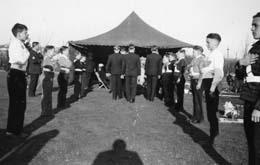Former Seattle resident John M. Leggett offers this account of participating in the Junior Safety Patrol during the 1930s while attending Seattle's Loyal Heights Elementary School. Called the Schoolboy Patrol, the Junior Safety Patrol (which now includes girls) was sponsored by the AAA Club, and begun in Seattle Public Schools in September 1928. Its purpose was to increase safety for children crossing streets to get to school.
Schoolboy Patrols
During the late 1930s while attending the Loyal Heights Elementary School at 2511 NW 80th Street in Seattle, I served as a member of the Junior Safety Patrol, sometimes referred to as "Schoolboy Patrols," which was an accurate description since in the beginning girls were not included.
The JSP was organized by the school in cooperation with the Seattle Police Department. It provided trained crossing guards at two intersections near the school grounds. Our responsibility was help students safely cross NW 80th Street and also 24th Avenue NW, the two nearby arterial streets.
Students living east of 24th were not permitted to cross either street at any point other than the intersection of 80th and 24th. Students living west of 24th and north of 80th were not allowed to cross 80th anywhere except at 26th. The rules were designed to insure the safety of students crossing these busy arterials and they were enforced appropriately by the school.
Most often I was assigned (along with at least one other student) to the intersection of 24th and 80th, which was two blocks east of the school. The immediate area was vacant land. There was not a traffic light then as there is now, but there was a stop sign for cars traveling 80th. Many students crossed both 24th and 80th on their way home.
The JSP also served at the 26th crossing. The school building was at the southeast corner of this intersection with houses on the other three corners.
The role of the JSP was to teach safety and model it. We were taught to "direct children, not traffic." We had authority over the students as they crossed streets so that they might do so safely. We did not have any authority over vehicular traffic on the streets.
We were trained to keep students out of the street and on the sidewalk until there was no approaching traffic. Our poles with bright red STOP flags were used to stop students from entering the street until we had determined it was safe to do so.
As students crossed we stood on each end of the crosswalk and held up our STOP flags. This was a warning to any vehicular traffic that might suddenly appear that students were crossing. It was not the same situation as today when a school bus extends a stop sign and traffic must stop under penalty of law. We were trained not to take chances by allowing students to cross and then hope that any cars that came along would stop because of our STOP flags.
Origin of the Patrols
Only recently while reminiscing and researching in connection with this article did I learn that the motivation for the establishment of Junior Safety Patrols did not originate with the schools or police but from another organization as part of their long-standing commitment to promoting safety.
The Chicago Motor Club in 1920 pioneered the concept of School Safety Patrols. The American Automobile Association Club in Western Washington began a Safety Campaign Plan in 1921, which included a variety of events in many communities to emphasize and teach safety on highways and streets. School teachers and children were a particular focus. Essay contests were sponsored and safety posters distributed to schools among other things.
When schools opened in September 1928, the Schoolboy Patrol program was begun in Seattle Schools. It was sponsored and equipped by the AAA Club.
The idea quickly spread around the state. In May 1930 the second annual schoolboy patrol picnic was held at Woodland Park with 1,000 boys and 150 adults attending.
Esprit de Corps
There was a strong "esprit de corps" among JSP members--and it sometimes included their families as well. I had an older brother who died at age 15 on my seventh birthday, April 22, 1935. According to my father, Billy was an original member of the Junior Safety Patrol and at his funeral there was a 12-member JSP honor guard wearing their badges on distinctive "Sam Browne" belts, which were the "uniform" of the JSP. My father was proud of me when I later became a member of the JSP.
The "Sam Browne" belt has a shoulder strap that runs diagonally across the chest. It is also a part of some military and police uniforms. The ones we wore were white -- almost gray -- in color. This was later changed to bright orange and more recently to "'Lectric Lime," which is even more visible to motorists. They are supplied by AAA clubs along with badges, training materials, and everything needed to organize and operate a School Safety Patrol program.
In some schools the duties of JSP members include raising and lowering the national and state flags each day.
All in all, the JSP program helped me and thousands of boys (and later, girls also) become responsible citizens with a genuine concern for the safety and well-being others. The total number of JSP members over the years is unknown but in 2002 there were more than 500,000 children participating at a total of 50,000 schools throughout the nation, according to the AAA.

